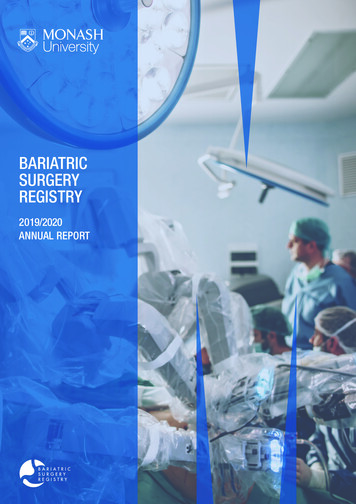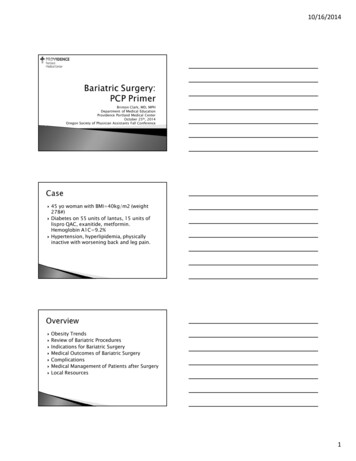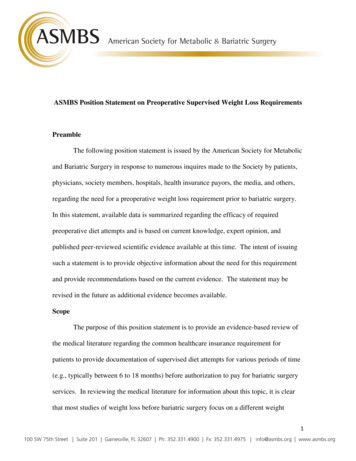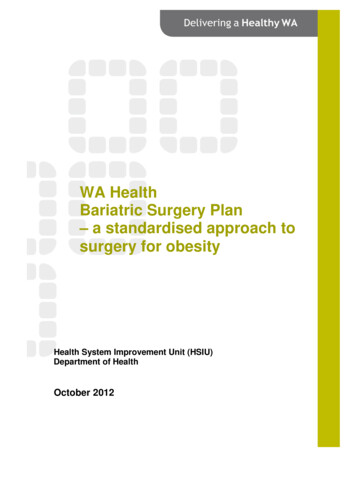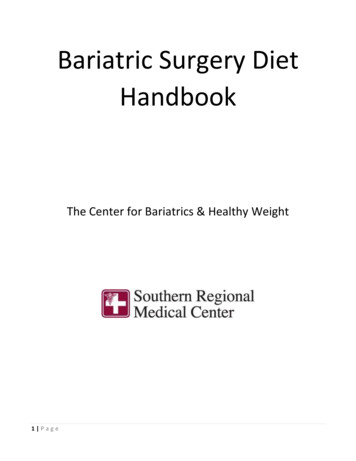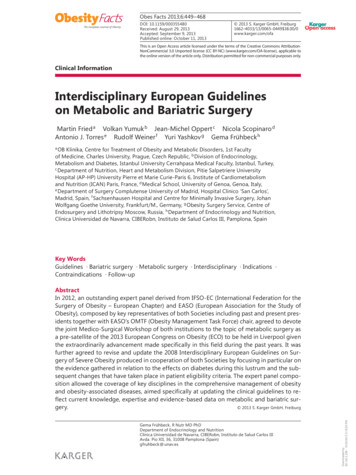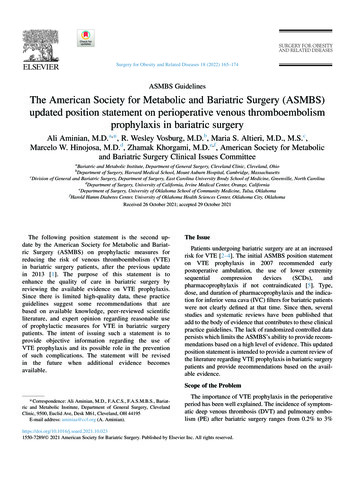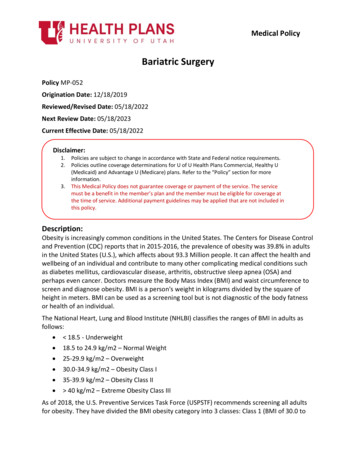
Transcription
Medical PolicyBariatric SurgeryPolicy MP-052Origination Date: 12/18/2019Reviewed/Revised Date: 05/18/2022Next Review Date: 05/18/2023Current Effective Date: 05/18/2022Disclaimer:1.2.3.Policies are subject to change in accordance with State and Federal notice requirements.Policies outline coverage determinations for U of U Health Plans Commercial, Healthy U(Medicaid) and Advantage U (Medicare) plans. Refer to the “Policy” section for moreinformation.This Medical Policy does not guarantee coverage or payment of the service. The servicemust be a benefit in the member’s plan and the member must be eligible for coverage atthe time of service. Additional payment guidelines may be applied that are not included inthis policy.Description:Obesity is increasingly common conditions in the United States. The Centers for Disease Controland Prevention (CDC) reports that in 2015-2016, the prevalence of obesity was 39.8% in adultsin the United States (U.S.), which affects about 93.3 Million people. It can affect the health andwellbeing of an individual and contribute to many other complicating medical conditions suchas diabetes mellitus, cardiovascular disease, arthritis, obstructive sleep apnea (OSA) andperhaps even cancer. Doctors measure the Body Mass Index (BMI) and waist circumference toscreen and diagnose obesity. BMI is a person's weight in kilograms divided by the square ofheight in meters. BMI can be used as a screening tool but is not diagnostic of the body fatnessor health of an individual.The National Heart, Lung and Blood Institute (NHLBI) classifies the ranges of BMI in adults asfollows: 18.5 - Underweight 18.5 to 24.9 kg/m2 – Normal Weight 25-29.9 kg/m2 – Overweight 30.0-34.9 kg/m2 – Obesity Class I 35-39.9 kg/m2 – Obesity Class II 40 kg/m2 – Extreme Obesity Class IIIAs of 2018, the U.S. Preventive Services Task Force (USPSTF) recommends screening all adultsfor obesity. They have divided the BMI obesity category into 3 classes: Class 1 (BMI of 30.0 to
34.9), Class 2 (BMI of 35.0 to 39.9) and Class 3 (BMI of 40). Also, clinicians should offer or referpatients with a BMI of 30 kg or higher to intensive, multicomponent behavioral interventions.The two main weight-loss surgeries offered for treatment of obesity are restrictive andmalabsorptive. Restrictive methods cause weight loss by restricting the amount of food that canbe consumed by making the stomach smaller. Malabsorptive methods cause weight loss bylimiting the amount of food that is absorbed from the intestines. A procedure can haverestrictive features, malabsorptive features, or both. The surgical approach may be open orlaparoscopic and the clinical decision on which surgical procedure (or a combination of both) isused will be made based on the medical assessment of the patient's individual situation.Potential issues related to bariatric procedures may include bowel perforations, adjustablegastric band migration (slippage) that cannot be corrected with manipulation or adjustment,leaks, obstruction, staple-line failure and mechanical adjustable gastric band failure.Policy Statement and Criteria1. Commercial PlansU of U Health Plans considers the following procedures proven and medically necessaryfor treating patients with obesity when the criteria below has been met:A. Roux-en-Y gastric bypassB. Bilio-pancreatic diversion with duodenal switch (BPD/DS) gastric bypassC. Sleeve gastrectomyU of U Health Plans does NOT cover gastric banding (e.g. LapBand ) bariatric surgerydue to lower efficacy and higher complication rates relative to other available options.It is considered not medically necessary.U of U Health Plans covers one bariatric surgery per lifetime, including all relatedservices, when the member is 18 years or older and the following criteria are met(Preauthorization is required):A. A documented history of a BMI 40kg/m2 for the preceding 3 years; orB. A documented history of a BMI 35kg/m2 with at least 2 of the following co-existingconditions:i. Medically refractory hypertension: persistent blood pressure readings of 140/90 mmHg (or 130/80 mmHg in diabetic patients) for a minimum of six(6) months despite use of at least two anti-hypertensive medications;ii. Uncontrolled diabetes (defined as a HgbA1c 7% of two (2) separateoccasions at least six (6) months apart despite taking at least two (2) diabeticmedications with separate mechanisms of action during this time;
iii. Dyslipidemia requiring medical therapy as defined by the American Collegeof Cardiology and American Heart Association guidelines;iv. Proven coronary artery disease OR cerebral artery disease;v. Obstructive sleep apnea (OSA) as diagnosed by a formal sleep study in anAmerican Academy of Sleep Medicine (AASM) certified sleep lab andinterpreted by a certified specialist in sleep disorders;vi. Obesity hypoventilation syndrome with a diagnosis supported by apolysomnography with continuous nocturnal carbon monoxide monitoring(performed in an AASM certified sleep lab and interpreted by a certifiedspecialist in sleep disorders), pulmonary function testing, a chest x-ray, andrelevant laboratory testing;vii. Debilitating arthritis with disqualification from surgery as a result of obesity.C. Active participation for at least 12 months in a structured, medically supervised nonsurgical weight reduction program. Documentation from clinical records mustindicate that all of the following have been met:i. Supervision is provided by an MD, DO, NP, PA; or a registered dietician orcertified health coach under the supervision of an MD, DO, NP or PA; andii. Participation has occurred during at least twelve months within the twentyfour months prior to the request for surgery; andiii. Include at least six visits occurring at intervals of no longer than sixty (60)days apart; andiv. Include a comprehensive medical and surgical history, review of current andpast medications/supplements, assessment of health-related behaviors (notlimited to substance use, sleep adequacy, nutrition, engagement in physicalactivity, stress management and coping skills), physical exam, andassessment of overall health as related to weight; andv. Document consideration and medically-appropriate utilization of weight lossmedications; andvi. Include assessment and counseling concerning behavior modification, withspecific focus on:a) Identification of eating and dietary styles (stress-related eating,nighttime eating, grazing, binging, etc.); andb) Recognition of personal lifestyle strengths and challenges as informedby patterns of prior weight losses or gains; andc) Incorporation of physical movement/activity into daily lifestyle habits;and
d) Identification of weight loss motivations and expectations, andmanagement of stressors and coping skills.D. Completion of a psychological evaluation, performed by a practitioner specializing insurgical weight loss, confirming patient suitability for the procedure as evidenced bythe lack of significant psychopathology which would impair ability to comply withpreoperative and postoperative recommendations.i. Behavioral: untreated mental health or personality disorders, health relatedrisk-taking behaviorsii. Cognitive and Emotional: cognitive functioning, knowledge of obesity andsurgical interventions, emotional modulationiii. Developmental Historyiv. Current Life Situation: stressors and utilization of social supportv. Motivations and ExpectationsE. The bariatric surgery must be performed at a center accredited by the Metabolicand Bariatric Surgery Accreditation and Quality Improvement Program (MBSAQIP).U of U Health Plans does NOT cover the reversal of a covered bariatric surgery unlessdeemed medically necessary to treat other health related issues or medicalcomplications.U of U Health Plans considers revisions of bariatric surgery, using one of the proceduresidentified above, as proven and medically necessary when due to a major complicationfrom the initial bariatric procedure.Non-covered Procedures:U of U Health Plans considers the following procedures NOT medically necessary fortreating due to insufficient evidence of efficacy:A. Revision of bariatric surgery for any other indication than those listed above;B. Bariatric surgery as the primary treatment for any condition other than obesity;C. Bariatric surgical interventions for the treatment of obesity including but not limitedto:i. Transoral endoscopic surgery;ii. Mini-gastric bypass (MGB) or laparoscopic mini-gastric bypass (LMGBP);iii. Gastric electrical stimulation with an implantable gastric stimulator (IGS);
iv. VBLOC vagal blocking therapy;v. Intragastric balloon;vi. Laparoscopic greater curvature plication, also known as total gastric verticalplication;vii. Stomach aspiration therapy (AspireAssist );viii. Bariatric artery embolization (BAE);ix. Single-Anastomosis Duodenal Switch (also known as duodenal switch withsingle anastomosis, or stomach intestinal pylorus sparing surgery.U of U Health Plans considers gastrointestinal liners (EndoBarrier ) investigational andunproven for treating obesity due to lack of U.S. Food and Drug Administration (FDA)approval, and insufficient evidence of efficacy.2. Medicaid PlansCoverage is determined by the State of Utah Medicaid program; if Utah State Medicaidhas no published coverage position and InterQual criteria are not available, the U of UHealth Plans Commercial criteria will apply. For the most up-to-date Medicaid policiesand coverage, please visit their website ry.php or the Utah Medicaid codeLook-Up toolCPT/HCPCS codes covered by Utah State Medicaid may still require further evaluationto determine medical necessity for coverage.3. Medicare PlansCoverage is determined by the Centers for Medicare and Medicaid Services (CMS); if acoverage determination has not been adopted by CMS, and InterQual criteria are notavailable, U of U Health Plans’ commercial policies would apply. For the most up-to-dateMedicare policies and coverage, please visit their search website verview-and-quicksearch.aspx?from2 search1.asp& or the manual website.Clinical RationaleThese criteria were adapted from the NIH Consensus Conference on Surgical Treatment of MorbidObesity (1998) which state that obesity surgery should be reserved only for patients who have firstattempted medical therapy: “Weight loss surgery should be reserved for patients in whom efforts atmedical therapy have failed and who are suffering from the complications of extreme obesity.”Pre-surgical Preparatory Regimen: The patient’s ability to lose weight prior to surgery makes surgicalintervention easier and also provides an indication of the likelihood of compliance with the severedietary restriction imposed on patients following surgery.
Given the importance of patient compliance on diet and self-care in improving patient outcomes aftersurgery, the patient’s refusal to even attempt to comply with a nutrition and exercise regimen prior tosurgery portends poor compliance with nutritional and self-care requirements after surgery. Therefore,the appropriateness of obesity surgery in non-compliant patients should be questioned. The patientmust be committed to the appropriate work-up for the procedure and for continuing long-term postoperative medical management, and must understand and be adequately prepared for the potentialcomplications of the procedure.There is rarely a good reason why obese patients (even super obese patients) cannot delay surgery inorder to undergo behavioral modification to improve their dietary and exercise habits in order to reducesurgical risks and improve surgical outcomes. The patient may be able to lose significant weight prior tosurgery in order to improve the outcome of surgery.An individual’s understanding of the procedure and ability to comply with life-long follow-up and lifestyle changes (e.g., as exemplified by compliance with previous medical care) are necessary for thesuccess of the procedure.Obesity makes many types of surgery more technically difficult to perform and hazardous. Weight lossprior to surgery makes the procedure easier to perform. Weight reduction reduces the size of the liver,making surgical access to the stomach easier. By contrast, the liver enlarges and becomes increasinglyinfiltrated with fat when weight is gained prior to surgery. A fatty liver is heavy, brittle, and more likelyto suffer injury during surgery. Moreover, following surgery, patients have to follow a careful diet ofnutritious, high-fiber foods in order to avoid nutritional deficiencies, dumping syndrome, and othercomplications. The total weight loss from surgery can be enhanced if it is combined with a low-caloriediet. For these reasons, it is therefore best for patients to develop good eating and exercise habitsbefore they undergo surgery.The pre-operative surgical preparatory regimen should include cessation counseling for smokers. TheNational Institutes of Health Consensus Statement (1998) states that all smokers should be encouragedto quit, regardless of weight. Smoking cessation is especially important in obese persons, as obesityplaces them at increased risk for cardiovascular disease. Severely obese persons are at increased risk ofsurgical complications. Smoking cessation reduces the risk of pulmonary complications from surgery.Ideally, the surgical center where surgery is to be performed should be accomplished in bariatric surgerywith a demonstrated commitment to provide adequate facilities and equipment, as well as a properlytrained and funded appropriate bariatric surgery support staff as individuals undergoing bariatricprocedures have unique medical needs and potential for complications not typically experienced withnon-obese patients. Minimal standards in these areas are set by the institution and maintained underthe direction of a qualified surgeon who is in charge of an experienced and comprehensive bariatricsurgery team. This team should include experienced surgeons and physicians, skilled nurses, specialtyeducated nutritionists, experienced anesthesiologists, and, as needed, cardiologists, pulmonologists,rehabilitation therapists, and psychiatric staff. The American College of Surgeons (ACS) has stated thatthe surgeon performing the bariatric surgery be committed to the multidisciplinary management of thepatient, both before and after surgery. The ACS recommended: "They develop skills in patient educationand selection and are committed to long-term patient management and follow-up. There is activecollaboration with multiple patient care disciplines including nutrition, anesthesiology, cardiology,pulmonary medicine, orthopedic surgery, diabetology, psychiatry, and rehabilitation medicine.Appropriate technical skills in the performance of bariatric surgical procedures are acquired."A number of studies have demonstrated a relationship between surgical volumes and outcomes ofobesity surgery. Most recently, an assessment by the Canadian Agency for Drugs and Technologies in
Health (CADTH) (Klarenbach et al, 2010) stated that their volume-outcome review found that highersurgical volumes were associated with better clinical outcomes. CADTH was not, however, able toidentify specific thresholds for surgical volume that were associated with better clinical outcomes.The above findings are supported by a Multidisciplinary Care Task Group (MCTG) (Saltzman et al, 2005)in which they conducted a systematic review of the literature to provide evidence-based guidelines forpatient selection and to recommend the medical and nutritional aspects of multi-disciplinary carerequired to minimize peri-operative and post-operative risks in patients with severe obesity whoundergo weight loss surgery. The Task Group recommended multi-disciplinary screening of weight losssurgery patients to ensure appropriate selection; pre-operative assessment for cardiovascular,pulmonary, gastrointestinal, endocrine, and other obesity-related diseases associated with increasedrisk for complications or mortality; pre-operative weight loss and cessation of smoking; peri-operativeprophylaxis for deep vein thrombosis and pulmonary embolism (PE); pre-operative and post-operativeeducation and counseling by a registered dietitian; and a well-defined post-surgical diet progression. Theauthors explained that obesity-related diseases are often undiagnosed before weight loss surgery,putting patients at increased risk for complications and/or early mortality. Multi-disciplinary assessmentand care to minimize short- and long-term risks include: comprehensive medical screening; appropriatepre-, peri-, and post-operative preparation; collaboration with multiple patient care disciplines (e.g.,anesthesiology, pulmonary medicine, cardiology, and psychology); and long-term nutritioneducation/counseling.The MCTG (Saltzman et al, 2005) also recommends that operative candidates must be committed to theappropriate work-up for the procedure and to continued long-term post-operative medicalmanagement. They must also be able to understand, and be adequately prepared for, potentialcomplications. The Multidisciplinary Care Task Group recommended the use of patient selection criteriafrom the NIH Consensus Development Conference on Gastrointestinal Surgery for Severe Obesity, whichare consistent with those of other organizations. These include: BMI greater than or equal to 40 kg/m2or BMI greater than or equal to 35 kg/m2 in the presence of significant co-morbidities, a well-informedand motivated patient with a strong desire for substantial weight loss, failure of non-surgical approachesto long-term weight loss, and acceptable operative risks.The MCTG further recommends that all weight loss surgery patients be encouraged to lose weightbefore surgery, and to promote 5 to 10% pre-operative weight loss in patients with a BMI greater than50 kg/m2 or obesity-related comorbidities (Saltzman et al, 2005). The Task Group recommended todecide on a case-by-case basis whether to proceed with surgery in patients who are unable to loseweight. The Task Group stated that registered dietitians are best qualified to provide nutritional care,including pre-operative assessment and post-operative education, counseling, and follow-up. Weightloss surgery patients need to learn important new skills, including self-monitoring and meal planning.Many forms of weight loss surgery require patients to take lifelong nutritional supplements and to havelifelong medical monitoring. Dedicated dietitians can help patients during their pre-operative educationon new dietary requirements and stipulations and their post-surgical adjustment to those requirements.A pre-operative assessment for micronutrient deficiencies is also recommended.Finally, the MCTG recommends that smokers should be encouraged to stop, preferably at least 6 to 8weeks before surgery (Saltzman et al, 2005). Bupropion and/or nicotine replacements arerecommended to help minimize weight gain associated with smoking cessation. Patients should beencouraged to remain non-smokers after weight loss surgery to reduce the negative long-term healtheffects of smoking.Anderin et al (2015) found that weight loss before bariatric surgery is associated with marked reductionof risk of postoperative complications. The investigators reported that the degree of risk reduction
seems to be related to amount of weight lost and patients in the higher range of BMI are likely tobenefit most from pre-operative weight reduction. The investigators noted that a pre-operative weightreducing regimen is usually adhered to in most centers performing bariatric surgery for obesity, and thatthe potential to reduce post-operative complications by such a routine is yet to be defined. Theinvestigators analyzed data from the Scandanavian Obesity Registry on 22,327 patients undergoingprimary gastric bypass from January 1, 2008, to June 30, 2012. In all patients, median pre-operative totalweight change was 4.8%. Corresponding values in the 25th, 50th, and 75th percentile were 0.5, 4.7,and 9.5%, respectively. Complications were noted in 9.1% of the patients. When comparing patients inthe 75th with those in the 25th percentile of pre-operative weight loss, the risk of complications wasreduced by 13%. For specific complications, the corresponding risks were reduced for anastomoticleakage by 24%, for deep infection/abscess by 37%, and for minor wound complications by 54%.Similarly, however, less pronounced risk reductions were found when comparing patients in the 50thwith those in the 25th percentile of pre-operative weight loss. For patients in the highest range of bodymass index (BMI), the risk reduction associated with pre-operative weight loss was statisticallysignificant for all analyzed complications, whereas corresponding risk reductions were only occasionallyencountered and less pronounced in patients with lower BMI.Body Mass Index as a Criterion for Candidacy for Obesity Surgery: Surgery for severe obesity is usuallyconsidered an intervention of last resort with patients having attempted other forms of medicalmanagement (such as behavior change, increased physical activity and drug therapy) but withoutachieving permanent weight loss (Colquitt et al, 2014; NIH, 1991). Surgery is indicated for persons withsevere obesity (BMI of 40 kg/m2 or more) or for persons with a BMI of 35 kg/m2 or more and seriousco-morbidities such as diabetes, coronary heart disease, or obstructive sleep apnea. Ideally patientsselected for surgery should have no major perioperative risk factors, a stable personality, no eatingdisorders, and have lost some weight prior to surgery. The patient's ability to lose weight prior tosurgery makes surgical intervention easier and also provides an indication of the likelihood ofcompliance with the severe dietary restriction imposed on patients following surgery.Rationale for Six-Month Nutrition and Exercise Program Prior to Surgery: The NIH ConsensusConference on Surgical Treatment of Morbid Obesity (1998) states that obesity surgery should bereserved only for patients who have first attempted medical therapy: “Weight loss surgery should bereserved for patients in whom efforts at medical therapy have failed and who are suffering from thecomplications of extreme obesity.”The NIH Consensus Conference states that the initial goal of medical therapy is a 10% reduction inweight, and that a reasonable duration for medical therapy is 6 months. The Consensus Conferencestated: “The initial goal of weight loss therapy is to reduce body weight by approximately 10% frombaseline. If this goal is achieved, further weight loss can be attempted, if indicated through furtherevaluation. A reasonable time line for a 10% reduction in body weight is 6 months of therapy.”The NIH Consensus Conference Statement (1998) explained "The rationale for this initial goal is thateven moderate weight loss, i.e., 10% of initial body weight, can significantly decrease the severity ofobesity-associated risk factors." The NIH Consensus Conference (1998) states that the combination of areduced calorie diet and increased physical activity can result in substantial improvements in bloodpressure, glucose tolerance, lipid profile, and cardiorespiratory fitness.The NIH Consensus Conference (1998) has stated that the patient should begin a nutrition and exerciseprogram prior to surgery: “An integrated program must be in place to provide guidance on diet, physicalactivity, and behavioral and social support both prior to and after the surgery.”
The American Dietetic Association (1997), in their position statement obesity surgery, recommendsdietetic counseling and behavioral modification commencing prior to, not after, surgery: "Carefuldietetics evaluation is needed to determine if the patient will be able to comply with the postoperativediet. A preoperative behavior change program with psychological evaluation should be required."More recently, evidence-based guidelines from the Scottish Intercollegiate Guidelines Network (2010)have stated that bariatric surgery should be considered on an individual case basis following assessmentof risk/benefit in obese patients with "evidence of completion of a structured weight managementprogram involving diet, physical activity, psychological and drug interventions, not resulting in significantand sustained improvement in the comorbidities."Candidates for obesity surgery should begin a weight reduction diet prior to surgery. The purpose of apre-operative nutrition program prior to obesity surgery are to test patient motivation, to reduceperioperative morbidity, to accustom patients to the restriction of food intake after surgery, and toincrease total weight loss (van de Weijgert et al,1999; Jung and Cusciheri, 2000; Pekkarinen et al, 1997;Martin et al, 1995). Even super obese patients (BMI greater than 50) may benefit from initiating anutrition and exercise program prior to surgery. Obesity itself increases the likelihood of pulmonarycomplications and wound infections (Choban et al, 1995; Abdel-Moneim, 1985; Holley et al, 1990; Myleset al, 2002; Nair et al, 2002; Bumgardner et al, 1995; Perez et al, 2001; Chang et al, 2000; Printen et al,1975). The higher the patient's BMI, the higher the surgical risk, and the highest risks occur amongpatients with a BMI over 50 (Gonzalez et al, 2003; Oelschlager and Pellegrini, 2003). Even relativelymodest weight loss prior to surgery can result in substantial improvements in pulmonary function, bloodglucose control, blood pressure, and other physiological parameters (Anderson et al, 1992; Hakala et al,1995; Kansanen et al, 1998; Pekkarinen et al, 1998). Factors such as blood glucose control, hypertension,etc., affect surgical risk. Garza (2003) explained that the patient should lose weight prior to surgery toreduce surgical risks. "The overall health of patients should be optimized prior to surgery to reduce thepotential for complications. Patients ought to be encouraged to lose as much weight as possible beforesurgery" (Garza, 2003). Although the long-term effectiveness of weight reduction programs has beenquestioned, the Institute of Medicine (1995) has reported the substantial short-term effectiveness ofcertain organized physician-supervised weight reduction programs.For maximal benefit, dieting should occur proximal to the time of surgery, and not in the remote past toreduce surgical risks and improve outcomes. Even if the patient has not been able to keep weight offlong-term with prior dieting, the patient may be able to lose significant weight short term prior tosurgery in order to improve the outcome of surgery.Given the importance of patient compliance in diet and self-care in improving patient outcomes aftersurgery, the appropriateness of obesity surgery in noncompliant patients should be questioned. TheAmerican College of Surgeons has stated: “Not all persons who are obese or who consider themselvesoverweight are candidates for bariatric surgery. These procedures are not for cosmesis but forprevention of the pathologic consequences of morbid obesity. The patient must be committed to theappropriate work-up for the procedure and for continuing long-term postoperative medicalmanagement, and understand and be adequately prepared for the potential complications of theprocedure. Screening of the patients to ensure appropriate selection is a critical responsibility of thesurgeon and the supporting health care team.”Requirement that Obesity be Persistent: Obesity surgery is not indicated for persons with transientincreases in weight (Collazo-Clavell, 1999). Guidelines of the American Association of ClinicalEndocrinologists and the American College of Endocrinology (1998) and guidelines on obesity surgeryfrom the Massachusetts Department of Health and Human Services (2006) state that surgery candidatesshould be severely obese for a period of time.
Post-Op Management: In an updated guideline on the integrated health nutritional guidelines forsurgical weight loss, the ASMBS (Parrott et al., 2017) states that optimizing postoperative patientoutcomes and nutritional status begins preoperatively. Patients should be educated before and afterweight loss surgery (WLS) on the expected nutrient deficiencies associated with alterations inphysiology. Although surgery can exacerbate preexisting nutrient deficiencies, preoperative screeningfor vitamin deficiencies has not been the norm in the majority of WLS practices. Screening is importantbecause it is common for patients who present for WLS to have at least 1 vitamin or mineral deficiencypreoperatively.In a systematic review, Jirapinyo et al. (2017) identified that despite initial successful weight loss, somepatients may experience weight regain following RYGB, thus showing the importance of close follow-up,early recognition and intervention. There is a lack of established definition of weight regain in thecurrent literature.The ASMBS published recommendations for the pre-surgical psychosocial evaluation of bariatric surgerypatients (Sogg et al., 2016). They recommend that bariatric behavioral health clinicians with specializedknowledge and experience be involved in the evaluation and care of patients both before and aftersurgery. Given the importance of long-term follow up after WLS, the preoperative psychosocialassessment provides a valuable opportunity for patients to establish a trusted connection to abehavioral health provider as an additional resource and integral participant in their postoperative care.The need to ensure that postoperative psychosocial care is available has been noted in establishedpractice guidelines and evidence suggests that such care is associated with better outcomes aftersurgery.Data continue to suggest that the prevalence of micronutrient deficiencies is increasing, whilemonitoring of patients at follow-up is decreasing. The ASMBS recommends that thei
A. Revision of bariatric surgery for any other indication than those listed above; B. Bariatric surgery as the primary treatment for any condition other than obesity; C. Bariatric surgical interventions for the treatment of obesity including but not limited to: i. Transoral endoscopic surgery; ii.


